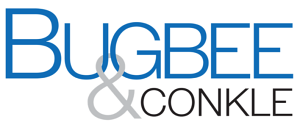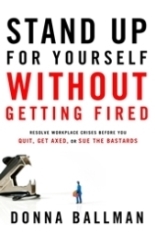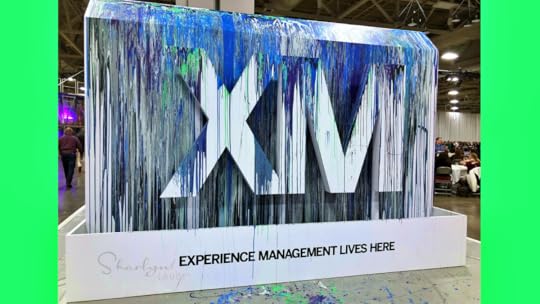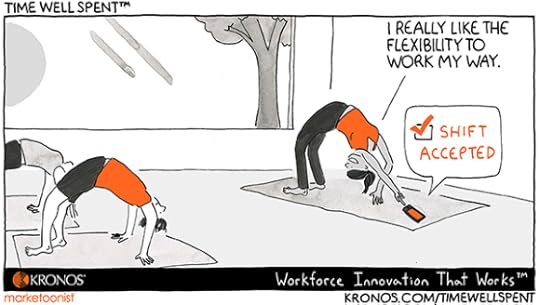Sharlyn J. Lauby's Blog, page 99
May 2, 2019
Providing Reasonable Job Accommodations – Ask #HR Bartender

We’ve talked about working from home before. Today’s reader note provides an interesting twist with regard to reasonable job accommodations.
I received a doctor’s note for an employee that says, ‘…saw the employee today and she can return to work, but the patient needs to be able to work from home until further notice.’ I know reasonable accommodations are required for a qualified disability, but I have no other information than that. What should I do?
Many of us are familiar with the term reasonable job accommodations as part of the Americans with Disabilities Act (ADA). Several states have their own laws mimicking the ADA which would be impossible for us to address in a single article.
But we haven’t talked about the ADA lately, so I asked Elizabeth Bolduc, an associate attorney with Bugbee & Conkle, LLP to share her expertise. She focuses her work in the areas of labor and employment law. Please remember that Elizabeth’s comments shouldn’t be construed as legal advice or as pertaining to any specific factual situations. If you have detailed questions, they should be addressed with your friendly neighborhood labor and employment attorney.
Elizabeth, welcome to HR Bartender. Obviously, we can’t address all of the state laws that are similar to the ADA. But from a federal standpoint, what are reasonable job accommodations?
[Bolduc] The term ‘reasonable accommodation’ comes from Title I of the Americans with Disabilities Act of 1990 (the ‘ADA’). The ADA requires employers to provide ‘reasonable accommodations’ to qualified employees or applicants with disabilities unless doing so would create an undue hardship or direct threat to others or themselves in the workplace.
A reasonable accommodation is essentially a modification or change in the workplace, including to an individual’s position or a workplace policy, to enable an individual with a disability to enjoy equal employment opportunities.
Are employers required to provide reasonable job accommodations? And if so, under what circumstances?

[Bolduc] Yes, under certain circumstances. The ADA applies to employers who employ 15 or more individuals (although state laws may, and tend to, require fewer employees).
As mentioned above, the ADA requires employers to provide reasonable accommodations to qualified disabled individuals unless doing so would create an undue hardship. An individual is ‘qualified’ if they can perform the essential functions of the position with or without accommodation.
Following the ADA Amendment Act of 2008 (ADAAA), the definition of ‘disability’ is construed broadly to mean, ‘a physical or mental impairment that substantially limits one or more major life activities; a record or past history of such impairment; or being regarded as having a disability.’
If these coverage prerequisites are met – meaning the employer is covered by the ADA, the individual is qualified for the position, and the individual is disabled under the ADA – then the employer’s duty to provide a reasonable accommodation is triggered when either:
A disabled employee or applicant requests an accommodation, or
When the employer becomes aware that a disabled employee needs an accommodation to perform their job.
From there the employer and disabled employee must engage in the interactive process, which is simply a dialogue between the two parties to determine what, if any, accommodation should be provided.
Are reasonable accommodations expensive? Why or why not?
[Bolduc] In my experience, there are many reasonable accommodations that are not expensive or even monetary for that matter. Remember an employer does not have to provide a reasonable accommodation that would cause an‘undue hardship’. Cost can certainly be a factor in demonstrating undue hardship to the employer.
Can you share some common reasonable job accommodations? Is working from home one of them?
[Bolduc] There are a number of possible reasonable accommodations that an employer may have to provide. Some common examples are:
Making existing facilities accessible; acquiring or modifying equipment;
Reassignment to a vacant position; part-time or modified work schedules;
Changing tests, training materials, or policies;
Providing qualified interpreters;
Job restructuring; reallocating or altering marginal job duties that a disabled employee is unable to perform; and
Leaving to obtain medical treatment.
Examples of unreasonable accommodations are creating a new position, eliminating the essential functions of the position, promoting someone, displacing a coworker, or where the individual’s disability imposes a direct threat to others or themselves in the workplace.
Whether working from home is a reasonable accommodation will depend on whether the essential functions of the position can actually be performed at home and/or whether physical presence is an essential function of that position. An employer may also consider, for example, its ability to effectively communicate with and supervise the employee at home, whether adequate work equipment can be installed at the employees’ home, and whether there are security risks in allowing the employee to work from home.
There are some jobs that by their very nature cannotbe performed at home, such as store clerk. However, it may be reasonable where an employee may perform the essential functions at home, such as a customer service representative.
When it comes to reasonable accommodations, are terms like “until further notice” the norm? Are employers able to push back and request more specificity?
[Bolduc] Without more context,it is hard to say. Employers are entitled to know that the individual has a covered disability for which it needs reasonableaccommodation and the individual’s limitations due to the disability.
When an individual’s disability and/or the need for accommodation is not obvious, an employer may require more specificity by requiring the individual to submit documentation about the disability and the functional limitations from the individual’s health care provider. However, the request for medical documentation must be relevant to the individual’s disability and need for accommodation. It does not privity the employer to know everything about the individual’s medical history.
In certain circumstances, an employer may require a medical examination by the health care provider of the employer’s choice, so long as the exam is limited to determining the ADA disability and the functional limitations that requiresan accommodation, but the employer must pay for the exam.

Last question. If employers have questions about creating reasonable accommodations, where can they go to learn more?
[Bolduc] There are a lot of FREE online resources that employers can use.
U.S. Department of Labor (USDOL)
https://www.dol.gov/odep/pubs/fact/ada.htm
Equal Employment Opportunity Commission (EEOC)
https://www.eeoc.gov/eeoc/publications/ada17.cfm
https://www.eeoc.gov/facts/ada17.html
U.S. Department of Justice (DOJ) ADA home page
Job Accommodation Network (JAN)
Americans with Disabilities Act National Network
A HUGE thanks to Elizabeth for sharing her knowledge with us. If you want to stay in touch with her (and I know you do), be sure to subscribe to Bugbee & Conkle’s publications at www.bugbeelawyers.com and follow her on Twitter @EmploymentLawEB.
While we might not talk about it every day, legislation like the Americans with Disabilities Act is still a big part of our roles. Understanding our obligations under the law is essential.
Image captured by Sharlyn Lauby after attending WorkHuman in Austin, TX
The post Providing Reasonable Job Accommodations – Ask #HR Bartender appeared first on hr bartender.






April 30, 2019
Everything HR Needs to Know About Experience Management (XM)
We talk about experiences a lot. Some of the experiences that immediately come to mind are the candidate experience, employee experience, and the customer experience. But I must admit when I think about these experiences, I lean toward the feeling that the person might have, versus data.
While an individual’s feelings about an experience are important, as business people, we also need to be focused on the data that the experience can generate for our organizations. At this year’s Qualtrics X4 Summit, I had the chance to speak with Bryce Winkelman, global growth and strategy leader for Qualtrics’ EmployeeXM product. We talked about – in general terms – what experience management is and why people need to take notice.
Bryce, let’s start with a definition. What is experience management (XM)? And when we talk about experiences, whose experiences are we talking about?
[Winkelman] Experience Management (XM) is the discipline of using both experience data (X-data) and operational data (O-data) to measure and improve the four core experiences of any business – customer, employee, product, and brand.
For decades, businesses have depended on O-data to understand what is happening – hard numbers like costs, accounting, and sales – to inform business decisions. X-data measures the human factor data – an individual’s beliefs, emotions, and intentions – that tell you why something is happening. Together, X- and O-data ensure every business decision is based on both facts and perceptions.
Why is experience management important to the business?
[Winkelman] In today’s experience economy, the value of any organization is dictated by the experiences of its customers, employees, and other constituencies, and those experiences can be shared and amplified globally and instantaneously. As a result, brand perception and reputation can shift quickly. Organizations that detect these factors and thoughtfully shape interactions with customers and employees can close experiences gaps, create differentiated experiences and sustain competitive advantage.
During the Qualtrics X4 Summit, I heard some conversations about the “experience gap”. What is it and why should organizations be concerned about it?
[Winkelman] Experience is all-important in winning and retaining customers and employees; however, actual experiences often fall short of expectations. The difference between the experience an organization believes they are delivering, and the actual experience delivered is the ‘experience gap.’ Experience gaps often have detrimental consequences for an organization, including lost customers, lower spend, complaints, employee turnover, employee disengagement, poor performance, and product failures.
I’d like to elaborate on the detrimental consequences that organizations can face as a result of experience gaps. Do you have a real-life example that you can share?
 [Winkelman] One of our founders, Jared Smith, told this story about Kmart earlier on stage.
[Winkelman] One of our founders, Jared Smith, told this story about Kmart earlier on stage.
He said that most customer and experience programs we see are based on a single instrument. Kmart went into bankruptcy with high customer satisfaction scores. How could they have high customer satisfaction yet declining sales on the other side?
Four years before their bankruptcy, Kmart hired Jared’s father to run a massive study. According to Wall Street, with $32 billion in sales, Kmart had the perfect retail model. The study was simple. A team of data scientists stood outside the stores and asked people coming in what they intended to purchase. And then, on the way out they grabbed their receipts and checked if they actually purchased what they intended to purchase.
So, what happened? Poor instrumentation. Kmart was a single instrumented system. And, believe it or not, they were ahead of their time, because they had a CX program in the 90s. It was only when they added additional instrumentation, in the case of purchaser intent, that they learned about the headwinds. By then it was too late.
Okay, lots of businesses track experience data. What can we learn from the Kmart story?
[Winkelman] As Jared mentioned, Kmart’s journey highlights what organizations should be worried about with XM programs today. They thought they were doing great, but in reality, they weren’t.
As Jared put it: performance is up and to the right, business looks great, things start to slow down, but management don’t notice, or they dismiss it and explain it away. Deep inside, people know something is wrong, but no one knows exactly what, because there’s poor instrumentation. At that point, you’re scrambling to get data and build the missing instrumentation to figure out what’s going on.
How can organizations use experience management to improve the business?
[Winkelman] Winning and not being blindsided takes a lot more instrumentation than sentiment analysis. The importance of building the right instrumentation at every step of the journey is the most pivotal.At Qualtrics, we help companies to:
Collect experience data from stakeholders at every meaningful touchpoint (such as employee onboarding or on an employee’s 5th work anniversary)
Analyze and understand why things are happening and what to do about it
Automate the actioning process that drives improvement across customer, employee, product, and brand experiences
Last question. What do you see as the future of experience management?
[Winkelman] Organizations today succeed or fail based on the experiences they deliver. Many organizations are still using traditional methods to simply gather data about customer and employee satisfaction, but that is no longer working as a competitive advantage. They are unintentionally racing to the bottom. The complexity and nuance of delivering great experiences has compelled executives to take ownership of these matters directly and in real-time.
When it comes specifically to HR, we believe that XM is more influential upon employee experience than just HCM systems. We are at an inflection point in HR today, where organizations are raising employee experience to a board level priority and expecting HR to shift from a cost center to a growth driver. Disruption happens in the experience gaps – just think about the taxi, entertainment, or financial services industries. Companies that compete on experience will unlock growth engines. Experience management will revolutionize the future of business, because experience is the future of business.
Organizations who embrace XM for employee experience allow managers and employees to identify experience gaps, gather real-time insights, and quickly take action at every meaningful touchpoint, from recruiting to on-boarding to performance management.
A HUGE thanks to Bryce for sharing his knowledge of experience management with us. I thoroughly enjoyed attending the Qualtrics X4 conference and look forward to sharing more insights with you in the weeks and months to come.
Experience management isn’t going away anytime soon. As we spend more time talking about experiences, we need to keep feelings in mind but also focus on the numbers. And Bryce’s comments reminded me that we can’t simply use a single number to measure our success.
Image captured by Sharlyn Lauby at the Qualtrics X4 Summit in Salt Lake City, UT
The post Everything HR Needs to Know About Experience Management (XM) appeared first on hr bartender.






April 28, 2019
You Can’t Tell Your Employees to Unplug If You Don’t Do It Yourself

Technology is a wonderful thing. It’s amazing what we can do today using technology.
That being said, technology can also create challenges. And I’m not talking about whether our technology works or not (although that can be a problem). There’s research that indicates our use of technology can have a negative impact on our wellbeing. I recently shared with you Dan Schawbel’s new book “Back to Human”, where he talks about technology creating workplace loneliness.
The answer? Well, one of the things we need to do is learn how to step away from technology every once in a while. My friend Mark Fogel recently wrote a post over on the SHRM blog titled, “HR, it’s Time to Get Your Employees to Unplug”. It’s a good read and definitely worth your time.
I would add one thing to Mark’s comments about HR encouraging employees to unplug and that’s HR needs to learn how to do it themselves. If you already know how, that’s fantastic! But as a human resources professional, I know unplugging is hard. I’ll admit that personally, I’m not great at it. It would be hard for me to tell employees to unplug if I don’t do it myself.
Over time, I’ve learned how to balance technology in my life. I’m still not perfect, but I’m working on it. So, if you’re struggling with the whole “unplugging thing”, here are a few things to consider:
Unplugging is going to look different for each of us. For some employees, unplugging means not being connected at night. For others, it means the weekend. It’s important for us to respect an employee’s “unplug time” even if it’s not the same as ours.
Communicate when you will be unplugged. If your unplug time is Friday date night or Sunday mornings with the kids, let others know so they won’t expect to hear from you. Maybe it’s me, but I think part of the stress associated with tech is that we feel compelled to answer things right away.
Don’t feel guilty about unplugging. This is easier said that done. But the key to getting employees to truly take a technology break and receiving the benefits of unplugging is not feeling guilty about doing it. We need to practice guilt-free unplug time. In fact, maybe we need to share with employees how nice spending time unplugged felt.
The business world moves very fast. I remember in my first HR job, my boss telling me “The work will still be there tomorrow. Don’t’ worry about it.” That doesn’t mean we didn’t stay late or come in over the weekend. Her point was that we would be better if we took time for ourselves. That means finding time to unplug from our devices.
Image captured by Sharlyn Lauby while exploring the streets of Las Vegas, NV
The post You Can’t Tell Your Employees to Unplug If You Don’t Do It Yourself appeared first on hr bartender.






April 26, 2019
Employees Want Flexible Work – Friday Distraction
(Editor’s Note: Today’s post is brought to you by our friends at Kronos , a leading provider of workforce management and human capital management cloud solutions. Want to create an inspired workforce? Check out Kronos CEO Aron Ain’s new book “ Work Inspired: How to Build an Organization Where Everyone Loves to Work ”. Enjoy the article!)
The title of today’s post says it all. Employees want flexible work. But what exactly does that mean? I know there’s a never-ending debate about whether to call something work-life balance or work-life integration. Is that what flexible work means? Or is that more of an outcome or result of having flexible work?
Today’s Time Well Spent cartoon from our friends at Kronos made me think that the definition of flexible work is two-fold with the focus on “flexible”.
Flexible work means that employees have the ability to be flexible when it comes to getting work done. Having flexibility doesn’t mean the quality of the work changes. Or that deadlines change. Those must be met. Flexible work means focusing on results not facetime. So flexible is about getting the work done the employee’s way. It means employees have the flexibility to work out the details on their own.
The other aspect of flexible work has to do with technology. Instead of waiting for a meeting or filling out a form, employees can use technology to keep others in the loop. They can work in the morning or in the evening. They can work on the weekend. This doesn’t mean that shifts can go uncovered or the operation will suffer. Flexible work means that employees can communicate their work needs in a flexible manner.
So, I wonder when we talk about flexible work if we’re describing a situation where 1) people have flexibility in how the work gets done and 2) they have flexibility in when the work is done.
Just like I’ve done here, organizations need to decide their definition of flexible work. I can see it being different in each organization. They should also clearly define what the outcomes of flexible work are. I can see situations where employees have some flexibility where their work is concerned but it doesn’t bring any level of work-life balance.
In addition, organizations promoting flexible work to candidates need to explain what that looks like. This could become an issue if a job candidate thinks they’re working for one type of “flexible work” company when, in fact, they’re working for another.
While I like my definition, I’m not here to say one definition of flexible work is better than another. But I hope we can agree there is some opportunity for the definition to be misinterpreted. Flexible work is too important of a benefit to have employees feel disappointed they’re not getting what they signed up for.
The post Employees Want Flexible Work – Friday Distraction appeared first on hr bartender.






April 25, 2019
Does Your Organization Support Employee Psychological Safety
The above image was taken at last year’s WorkHuman Conference. It’s of the walkway from our hotel (over a busy street) to the convention center where the event was being held. It’s very convenient.
But as you can see, the walkway is also very unusual. It’s made of concrete on the top and bottom. Super sturdy. And the sides might look open but there really some sort of chicken wire, so it appears there’s nothing. It’s cool and unnerving at the same time.
The reason I’m bringing up this walkway is because after I left WorkHuman, I went to the Association for Talent Development’s (ATD) annual conference. One of the biggest topics being discussed was psychological safety.
Psychological safety is the belief that you won’t be punished for making a mistake. I’ve mentioned before that it’s refreshing to see well-known entrepreneurs like Spanx founder Sara Blakely and Sir Richard Branson openly discuss their mistakes. Studies show that psychological safety allows individuals to take moderate risks, such as speaking their mind or challenging the status quo, without fear. These actions can often lead to innovation and breakthroughs.
I immediately thought of the walkway at WorkHuman.
Robin Schooling wrote a post about the walkway as well. She wondered if the event organizers intentionally chose the venue because of this walkway that challenged us each day to take a short “uncomfortable, sweat-inducing, heart-palpitating journey in unfamiliar terrain”? While I’m not sure that Globoforce did, Robin’s metaphor is spot-on. And it raises the question, what are organizations doing to support psychological safety in the workplace?
This is one of those concepts that you just can’t say “We encourage employees to speak up.” Or “Nothing bad is going to happen if you use radical candor.” Employees need to see it to believe it. And if they don’t see the conversation happening, then they need to see the result. For example, show employees the latest company product or service and say, “We thank Cecil for speaking up about this project. Thanks to him, we were able to make the product even better. Our clients love it.”
Organizations that are looking to break barriers need to create workplaces where employees feel safe. Managers need to role model the behavior they wish to see. Employees at every level need to receive training so they can deliver tough messages in the most effective way possible. And all of this needs to be reinforced during the candidate, new hire, and employee experience.
It won’t be easy. The rewards for individuals, teams, and organizations is huge.
Image captured by Sharlyn Lauby at the WorkHuman Conference in Austin, TX
The post Does Your Organization Support Employee Psychological Safety appeared first on hr bartender.






April 23, 2019
Build Your Recruiting Pipeline: Use Pre-Employment Assessments to Highlight Talent
(Editor’s Note: Today’s post is brought to you by our friends at Criteria Corp, a leading provider of pre-employment testing services. If you want to learn more about how pre-employment testing can benefit your recruiting strategy, check out Criteria Corp’s “Definitive Guide to Pre-Employment Testing”. I found this to be a comprehensive resource that I keep on the corner of my desk all the time. Enjoy the post!)

Many famous CEOs have said that employees are the cornerstone of their business. No matter what industry you’re in, employees play a key role in helping the organization take care of customers and ultimately achieve its goals. So regardless of what’s happening today with the unemployment rate, organizations want to create a recruiting process that helps them find the best talent.
Pre-employment assessments are a part of that process.
It’s time for us to reconsider how we’re using pre-employment assessments. Instead of using an assessment to filter out candidates, organizations should consider using them as a way to filter in high-potential candidates. What I mean by that is, pre-employment assessments can be used to surface candidates that the company might have overlooked based on their resume alone. Soft skills are a perfect example. Organizations can use cognitive ability assessments to identify areas of potential and trainability in candidates. Something that might not be obvious from a resume.
Using Assessments to Find the Best Talent
Before an organization starts using pre-employment assessments to highlight talent, they should examine four key areas of their recruiting strategy.
Decide the goal of using pre-employment assessments. Any time an organization uses an assessment, the company needs to decide and agree on the reason. What’s the purpose? Using an assessment to filter out candidates is going to be different from using it to highlight talent. The purpose will drive many other decisions. Also, make sure that the assessment being used is valid and reliable for the employment process. Valid means the assessment measures what it’s supposed to measure. Reliable means the same results happen in a consistent fashion. There are many terrific assessments on the market, but they are not all valid and reliable for recruiting purposes. Choosing the right assessment will help deliver the intended result.Consider conducting cognitive ability assessments earlier in the hiring process. According to CareerBuilder’s 2018 recruiting forecast, forty-five percent (45%) of HR professionals currently have jobs that they can’t fill because they cannot find qualified candidates. As a result, many organizations say they’re willing to hire candidates and train them. They just want to know that the candidate is trainable. As I mentioned earlier, this is the perfect application for cognitive ability assessments. The organization can use the assessment to uncover the candidate’s potential. But the ideal time to learn this information is early in the interview process not after the hiring manager has selected a candidate. This would change when in the hiring process an assessment is administered. Include behavioral career development interview questions. This ties into #2. Once the organization receives the results of the candidate’s cognitive ability assessment, then there might be an opportunity to ask a few follow-up questions. Of course, that only really works if the assessment is conducted early in the recruiting process. The key here is to make the questions behavioral in nature. Ask employees to tap into their past experience and share stories about what they’ve learned in the past. An example would be “Tell us about a time when you needed to learn something on your own.” Or “Tell us about a situation when your boss asked you to do something you didn’t know how to do. How did you handle it?” Provide training to everyone involved in administering and evaluating a candidate’s assessment results. When the goal of using an assessment is to filter candidates into the organization, the assessment results will be used long after the recruiting process. It’s essential for everyone to be able to read, understand, and react to the results. For instance, at the point the candidate becomes an employee, the company could use the cognitive ability assessment results as part of a personalized onboarding journey map for the new employee. The manager will also want to consider those results as part of a career development plan.

Assessments Help Organizations Find the Best Talent
Pre-employment assessments can help organizations find the best talent … and this has always been their goal. Instead of using an assessment to weed people out of the process, flip the process and use assessments to bring people in. It does mean making a few changes, but the results can be much more positive.
P.S. If you want to learn more about using pre-employment assessments to highlight talent, take a listen to the webinar I did with Criteria Corp on “Hiring for Soft Skills: 3 Strategies to Find the Best Candidates”. We go further in depth with this concept and talk specifically about the skills organizations can start evaluating earlier in the hiring process.
The post Build Your Recruiting Pipeline: Use Pre-Employment Assessments to Highlight Talent appeared first on hr bartender.






April 21, 2019
Employees: This Is What You Should Do If You Get a Suspension – Ask #HR Bartender

I’ve written before about employees who have been suspended. In those older questions, the focus has been on the details of the incident. This reader note has a bit of different twist. It’s focused on what the employee should do.
I got suspended pending an investigation and did not get any details. It’s been a week. What kind of questions can I ask my boss so I’m not on a limb?
Before you say to yourself, “We can’t answer anything because we don’t know what happened.” Yes, that’s true. We don’t know what the employee was accused of. But there are some steps that an employee should take anytime something like this happens.
To offer some insights, I asked employment attorney Donna Ballman to help us out. She’s helped us before with one of my favorite posts titled, “Can You Bring Your Mother to a Meeting With HR?” Donna’s work focuses on employee-side employment law issues, so whether you’re an employee or an HR pro, these insights will prove to be valuable. Also, please remember that Donna’s comments should not be construed as legal advice or as pertaining to any specific factual situations. If you have detailed questions, they should be addressed directly with your friendly neighborhood labor attorney.
Donna, just as a refresher for our readers, what does “suspension pending investigation” mean?
[Ballman] Sometimes employers will suspend an employee if there is a complaint or possible disciplinary issue so they can investigate.
If an employee is suspended, what basic information should they know about the circumstances of their suspension?
[Ballman] There are three key questions employees need to ask:
Find out if the suspension is with pay or without pay. Regardless of the answer, ask how long the suspension will be. A suspension without pay for an indefinite amount of time can amount to a termination. Employees don’t have to wait months or years to apply for unemployment or start applying for another job. If it’s a suspension with pay, that’s not a termination.Ask what you are expected to do during the suspension. There may be required times to check in with a supervisor or HR. Employees may be prohibited from entering the premises, even to have lunch with a coworker. If the premises have other offices like a doctor’s office and you need to go there during the suspension, make sure that won’t be held against you.Ask yourself whether others did the same thing you were accused of who weren’t suspended. This last question is for the individual. What’s happened to others in a similar situation. And were they of a different race, age, sex, national origin, or other protected status from you? Or were you suspended right after announcing a pregnancy, seeking FMLA, or seeking a disability accommodation? If so, then the suspension might be illegal discrimination.
If you think you have potential claims, you might want to take some time during the suspension to talk to an employee-side employment lawyer in your state about your rights and discuss some strategy.
This note says the employee has been suspended a week. In your experience, how long is the typical suspension?

[Ballman] There’s really no such thing as a ‘typical’ suspension. That being said, I hear x-number of days or x-number of weeks as the most common suspensions.
It’s really a dirty trick to suspend indefinitely without pay because the employee is in limbo and doesn’t know if they are still employed or not. Some employers will do this and then claim the employee quit when they apply for unemployment or start applying for other jobs.
I would completely understand if an employee is surprised by being suspended and they forget the information. Who should they follow-up with if they have questions about their status?
[Ballman] If they have questions, they should ask HR or the person who suspended them. I suggest getting any clarification in writing, such as by email or text, and keeping a copy for proof.
If you get no response, maybe check with someone higher up. Failing to respond is really unprofessional.
Last question, if an employee feels that the company is taking too long or not responding to their questions, is there something they can do?
[Ballman] At some point, and it’s hard to judge, a suspension without pay is a firing. It’s hard to say where that line is, but the employee needs to follow up and if nobody is responding, then it may be time to apply for unemployment and start applying for other jobs.
What employees don’t want to do is start contacting witnesses or the person who complained about them. This could result in being fired for interfering with the investigation. Also don’t start threatening or doing anything that could be deemed insubordination. You are under a microscope, so don’t give the company a reason for termination.

My thanks to Donna for sharing her knowledge with us on this difficult topic. Please be sure to check out her blog, Screw You Guys, I’m Going Home. It’s been named one of the American Bar Association’s 100 best legal blogs. And she’s the author of the award-winning book “Stand Up for Yourself Without Getting Fired: Resolve Workplace Crises Before You Quit, Get Axed or Sue the Bastards.”
While organizations should be providing employees with information during suspensions, I also believe that sometimes the employee is in shock about what’s going on and they forget to ask. If companies want to get to the truth, then they need to answer employee questions. I totally agree with Donna that it’s incredibly unprofessional to leave an employee in limbo.
Image captured by Sharlyn Lauby while exploring the streets of Oklahoma City, OK
The post Employees: This Is What You Should Do If You Get a Suspension – Ask #HR Bartender appeared first on hr bartender.






April 19, 2019
Bookmark This! Parental Leave Policies Edition

Sadly, I must admit that I received this question a while ago and have been looking for a way to offer some good resources. Parental leave is an important subject and one that the U.S. often fails at miserably.
Hi Sharlyn. Quick question for you: what do you think is a ‘good’ maternity policy for a startup of 15 people to have? My company is in Missouri and they offer disability, which is all that is legally required. I’m working on building a business case for more but am struggling with a baseline for a company of our size. Any thoughts or suggested resources? Thanks!
This question is so hard for many reasons. We don’t know what industry the company is in. It’s possible the industry has a baseline that should be considered. We also don’t know the company’s growth plans. The organization might want to think about the future when making this type of decision instead of creating a policy today and then changing it in a year or two. I’m taking a broad approach, but here are a few resources to consider when it comes to parental leave:
First of all, if you are a member of the Society for Human Resource Management (SHRM), then you have access to their “Ask an Advisor” member benefit. You can call, chat or email with an advisor who will send you relevant resources. I’ve used it for inclement weather policies, breaks and lunch policies, etc.
Additionally, the SHRM website has a forms section, where you can find parental leave forms as well as information about California parental leaves and guarantees of reinstatement. Not only do companies need to think about the best benefits to attract and retain talent, but how to legally implement and maintain those benefits.
If you’re looking for a specific policy that will give you some creative inspiration, I shared some details about Cisco’s parental leave policy in the post “Organizations: It’s Time for Family Friendly Leave Programs”.
And if you’re trying to sell a policy to senior management, it might be helpful to check out this post where our friends at Kronos share the details of their MyTime program, an open vacation benefit. While this reader note isn’t about unlimited vacation time, Kronos’ MyTime program provided them with the cost savings to expand their parental leave benefits.
We don’t always have to look at the United States to get creative inspiration about employee benefits. This infographic shares some information about parental leave policies around the world.
Finally, it’s important to remember that parental leave is a topic that is changing rapidly. Michael Carty from XpertHR discussed the impact of UK’s shared parental leave lawrecently in an HR Bartender post.
Parental leave is an important topic. Employees want to know that they are working for a company that respects their family life. Today and in the future. Honestly, it’s just good business. Ultimately, organizations will want to do their homework and create a benefit that aligns with their company culture.
Image captured by Sharlyn Lauby at the Venetian Resort Hotel in Las Vegas, NV
The post Bookmark This! Parental Leave Policies Edition appeared first on hr bartender.






April 18, 2019
HR Careers for Legal Professionals – Ask #HR Bartender

I’ve been asked many times to share resources about HR careers and becoming a human resources professional. Today’s reader note has an interesting facet – they’re studying to be a lawyer.
Hi there. Thanks for taking out the time to read my query. I am a law student currently in my final year. I’m contemplating earning a Master’s in Business Administration (MBA) with human resources as my specialization. I have received a call from a respected business school with one of the best HR programs in the country. I want to make an informed decision whether to pursue the Master’s so I have a couple of questions:
I’m struggling with how I would align my existing legal knowledge with the knowledge I would gain in a business / HR program. It would really be very helpful if you could provide me with some guidance regarding this. That leads me to my second question. What HR opportunities could be leveraged by a legal person such as myself?
Any help would be welcome. Thanks again.
Obviously, the decision to earn a degree (and in what subject) is a very personal one. So, I don’t know that it would be fair to give out specific advice. But there is definitely a relationship between HR and the law.
When I received this note, I immediately thought of a friend of mine who I know has sat on both sides of the HR and law table. Carrie B. Cherveny, Esq. is senior vice president of strategic client solutions and chief compliance officer at HUB International Southeast, an insurance brokerage providing a full-suite of coverage, investment, benefits, and wealth management services. Luckily, I asked Carrie if she would share her story and she said “yes”.
Carrie, I know you’ve been both an HR pro and now you’re a practicing lawyer. What would you say are the common knowledge, skills, and abilities (KSAs) between the two professions?
[Cherveny] In the role of legal advisor and in human resources I have always understood that I was there to serve and support both internal and external customers. I am, at the very core – a in a service role. My philosophy:
I am here to serve and support those who rely on me.When someone calls me, he/she is likely concerned/stressed – it’s my responsibility to do what I can to put him/her at ease, make a potentially difficult call as pleasant as it can be, and most of all – be helpful and responsive.There’s always someone out there who would be happy to take my place, so I remind myself each day that I’m fortunate to do the job I do.
It’s this philosophy that has shaped my paradigm for the job I do and the service I provide. The four KSAs that I use every day are:

A Service Mentality – My first job in human resources was in the hospitality industry. After I completed my masters, I began working for Marriot International in its healthcare division. At 24 years old (or so) I traveled to Washington DC where I spent several days at the Marriott International headquarters. Many years later I still remember the vital lessons I learned: 1) We are here to serve those who rely upon us and 2) Our service should be courteous, professional, and prompt
Analytical Skills – Near the end of my HR career, I worked for a boss that required I develop a myriad of spreadsheets and conduct extensive data analytics. I’ve grown to appreciate his insistence that we compile data, organize it in a variety of ways, and look for patterns, details, and anomalies to help better understand our circumstances. Both as an attorney and an HR professional you have to allow the facts, data, and documents tell the story.
People and Communication Skills – I’ve met all kinds of HR professionals and attorneys in my life and those who excelled in their profession were the same people who knew how to communicate with and relate to the people they served. Empathy, compassion, and the ability to deliver constructive and honest feedback are key skills for an HR person and an attorney.
Reading People and Circumstances – Both as an attorney and as an HR professional, reading the person that you’re speaking with, along with contextual circumstances, is an extremely valuable skill. What I have learned is that in all cases there is more going on than what ‘meets the eye’. Pay attention to non-verbal’s, tone of voice, facial expressions, and the smallest details and pieces of information. The details tell the story.
If I’m a legal professional considering HR careers, what would I be surprised to find out about the job?
[Cherveny] I think attorneys would be surprised by the nature of many of the issues that make their way to the HR department. Quite frequently, the nature of the issues that arrive in human resources can (at times) be relatively small or inconsequential. Attorneys generally become involved in matters of significance, consequence, or risk. However, the day-to-day in human resources can be quite different.
HR professionals very frequently do far more than employee relations. I think an attorney may be surprised by the variety of projects and areas of work that arrive in the HR department. As an HR professional I’ve been responsible for in projects including marketing, budgeting, sales, safety/OSHA, purchasing, commercial insurance, and vendor relations/negotiations.
And let’s do the reverse. If I’m an HR pro and decide to get my law degree, what would I be surprised to learn?
[Cherveny] Your professional success won’t mean much in law school. By the time I went to law school I had been in charge of two different HR departments for multi-million-dollar organizations. I was mentoring several new HR professionals and I was a frequent contributor and speaker at HR events. I was confident. I was successful. I was totally unprepared!
Think of law school as a total reboot. Who you were in your past professional life is not particularly relevant in law school – especially in the first year. The first year of law school is a pre-defined curriculum. In year-two you can begin to add electives. Imagine my excitement to finally take an employment- law class! After 12 months of total discomfort and stress I was sure I was going to finally find my groove. I was very excited to read all those cases that I heard attorneys reference throughout my HR career. Wrong! Would you be surprised to learn that my employment law class was my third most difficult class in law school (just behind property and agency)? It was!
Why was it so difficult for me? What I learned during my time as an HR professional was the practical application of legal principles. Black-letter law and cases are very different than real-world application. Law school will remake you into someone stronger and more capable than you ever imagined you could be. Trust the process. Be prepared to feel like a fish out of water for at least the first semester. Be open to reinvention. Be excited about the possibilities.
One of the things that I was surprised to learn is that some individuals study the law and get a law degree, but don’t practice law. Is this a strategy? What are the pros / cons to this approach?
[Cherveny] Sometimes it’s a strategy – sometimes it’s a necessity because of challenges passing the bar. In today’s increasingly competitive educational environment, a Juris Doctorate (aka ‘JD’) is a way to set you apart from the MBAs and other advanced degrees. Let’s talk about the cons first:
CON: Law school is expensive! And stressful!!Even in-state tuition at a public law school is by no means a cheap endeavor. Individuals who choose to attend law school and take advantage of law-school loans should be prepared to carry some significant debt after graduation.
Law school stress is nothing like any other stress I had experienced. I had a master’s degree, worked in corporate America, been in court hearings, depositions, board meetings, and even had a shoe thrown at my head by a very angry CEO. I thought I knew stress and anxiety well – I felt we were old friends! Law school is a completely different kind of stress and anxiety. Its fiercely competitive and failure of any kind is completely public.
CON: Perception of a JD vs. Practicing Attorney– recently I was partnering with a co-worker who is a JD but chose not to sit for the bar. Instead, she went right to work and is now a very successful sales professional. She shared with me that initially when she graduated from law school, she encountered some people who viewed her choice not to sit for the bar negatively – as if she were somehow less qualified or less intelligent than other people who had a JD and sat for the bar exam.
PRO: Competitive Edge- In a world where MBAs seem to be a far more common achievement – JDs remain a unique and impressive achievement. A JD sets you apart from many of the other advanced degrees in a very competitive educational environment.
PRO: Versatility and Relevance- When I was making the decision to go to law school everyone had an opinion. I was well on my way in my career and had already realized some significant success and growth in my career path. Why would I toss it all aside? Because I knew that a JD degree could never be a bad thing.
While I initially followed the traditional path of litigation, in the past 8 years I’ve had non-litigator opportunities become available to me that never would have been an option without my JD. The work that I do now – helping clients operate compliant employee benefit plans and HR departments – would never have been available to me without a JD. Regardless of whether you take a traditional path of litigation or go in another direction with your JD it will be something that you rely on throughout your career.
Last question. The reader mentions talking to a college / university in evaluating HR careers. What are 2 – 3 questions that someone considering a Master’s or Juris Doctorate should ask (to help them make this decision)?
[Cherveny] To quote Stephen Covey, ‘Begin with the end in mind.’ I would suggest finding professionals who have achieved the goals that you are considering for yourself. Find individuals working in the field or industry of your interest. If you’re interested in a JD and applying it to a corporate position, then speak with executives in organizations who have a JD and never practiced law. Ask the questions that will help you make your decision:
Was the JD helpful or instrumental in his/her success? How did the JD add value to his/her career and growth?Would he/she do it the same way if he/she did it all over again? What would he/she do differently? As a person who makes hiring decisions, would he/she value a candidate with a JD over a candidate without one? What skills and experience are most important to him/her when making a hiring decision?
Another great resource is recruiters. Speak with recruiters who recruit for your industry of interest. Recruiters will have the best view into the job market and the desirable educations, skill-sets and experience.
A huge thanks to Carrie for sharing her experiences with us. As the mantra of “owning your career” becomes more popular it’s important to do our homework and ask ourselves a few questions before making big career decisions. Carrie’s advice to reach out to your network and understanding the job market are spot on no matter what career path you’re considering.
Image captured by Sharlyn Lauby at the WorkHuman Conference in Austin, TX
The post HR Careers for Legal Professionals – Ask #HR Bartender appeared first on hr bartender.






April 14, 2019
FREE Learning Opportunity: Kronos Spring #HR and #Payroll eSymposium

(Editor’s Note: Today’s post is brought to you by our friends at Kronos , a leading provider of workforce management and human capital management cloud solutions. For the second consecutive year, Kronos has been named one of the . Many congratulations to them! Enjoy today’s article!)
Last fall, I shared with you a wonderful (and FREE!) learning opportunity offered by our friends at Kronos. Well, it’s back by popular demand. The spring HR & Payroll eSymposium will be held on Wednesday, May 1, 2019 from 10 a.m. to 5 p.m. Eastern. This is one event you do not want to miss.
I don’t have to tell you about the importance of professional development. But I also know that sometimes we’re so focused on everyone else’s development that we forget to schedule time for ourselves. That’s why I wanted to share with you some specifics about this event.
HR and Payroll eSymposium Agenda
The eSymposium is designed to bring HR and payroll professionals education on the topics we deal with most. This one-day experience will offer three tracks – HR, payroll, and workforce management – with many sessions eligible for recertification credits (more on that in a minute). As participants, we can follow one track or switch back and forth to explore the topics that we think matter most to our organizations. I checked out the agenda and there are five sessions that caught my eye, both HR and payroll related.
The Turning Employee Experience into Financial Strategy – If you’ve never had the opportunity to hear John Frehse, senior managing director at Ankura, speak, this is your chance. John is going to talk about the challenges associated with quantifying the value of investment in employees — and how this lack of clarity can cause an unintentional misallocation of human capital investments. He’ll explain the steps that organizations can take to improve the employee experience through strategy and technology.
The Future of Work: Don’t Believe All the Hype About Robots Wiping Out Human Jobs – Another speaker that I was delighted to see on the agenda was Mollie Lombardi, co-founder and CEO of Aptitude Research Partners. She’s going to share what steps top companies are taking today to balance people and automation along with some strategies for integrating people and technology to adapt and stay competitive. Prepare now for the changing technology and employment landscape.
But strategy sessions aren’t the only type of content being offered during this eSymposium. We’ve seen a lot of conversation lately about compliance matters and I was happy to see that this event is going to cover those issues from both a payroll and HR perspective.
Charting Your Course Through Changing Regulations – Explore how a multistate workforce comes with challenges that include compliance with a variety of rules and regulations across different states and municipalities — some of which may conflict with federal law — and how failure to comply could be quite costly. Multnomah Group Senior Consultant and CCO Bonnie Treichel will not only cover recent and expected changes but she will also discuss best practices for monitoring changes to the rules to ensure that HR can grow the company without drowning in legalese.
Payroll Compliance Update: New Laws and Required Changes in 2019 –The requirements of the Fair Labor Standards Act (FLSA) are complex and often misunderstood by employers. These misinterpretations about how the FLSA is applied and the rules for determining overtime pay can expose an employer to millions of dollars in back pay claims. Calvin House, partner with Gutierrez, Preciado & House, LLP,will explain the requirements for white-collar exemptions, how tipped employees are treated under the FLSA, the facts that the Department of Labor (DOL) uses to determine whether a worker is exempt as an intern, as well as trends in enforcement.
And in full disclosure, I certainly hope you will take a few moments to listen to my interview with Kronos CEO Aron Ain. During the interview, Ain takes us inside Kronos’ award-winning culture, showcasing the surprisingly simple rules that any organization can follow to replicate their success. Kronos employee engagement has continued to climb to an all-time high of 87 percent and has earned the company many coveted best-place-to-work distinctions around the world, including the Society for Human Resource Management (SHRM) When Work Works, Glassdoor’s 100 Best Places to Work, and Forbes’s America’s Best Employers.
Work Inspired: How to Build an Organization Where Everyone Loves to Work – Imagine a company where everybody loves to work, where employees feel not just “satisfied” but truly cared for, respected, and energized. Think of the impact this would have on recruitment, retention, customer satisfaction, innovation, and overall performance. This session will focus on how to create an inspired culture by embracing employee development and engagement as a growth strategy, including holding managers accountable and giving employees their time back.
Now of course, I couldn’t list the entire agenda (as much as I would love to). This is just a sampling of the sessions being offered. You’ll notice when you check out the complete agenda on the Kronos website that there are more sessions than you have time. Please don’t let that discourage you!

Listen to the Recordings if You Can’t Make the Live Event
There will be recordings of each session and you’ll be able to download any session materials. So, if you’re not able to listen to the live sessions on May 1 OR your learning preference is to space listening out over time, then you certainly can. That’s the beauty of this learning format.
Also, let me add that there have been a few times in my career when I’ve been responsible for both human resources and payroll. Having an event for both payroll and HR is a big selling point. I could see this as an opportunity to bring everyone together, order lunch, and listen to a session as a group. Because the event is free, it’s a good way to encourage HR to learn more about payroll and vice versa.
As someone who has attended Kronos conferences in the past, I can speak from experience that Kronos delivers quality professional development. I know that I’ll be signing up for the eSymposium and hope you will do the same.
Kronos HR & Payroll eSymposium
Wednesday, May 1, 2019
10 a.m. to 5 p.m. Eastern
Registration and Details:
https://www.kronos.com/about-us/events/kronos-hr-payroll-esymposium-5-1
Oh, and P.S. The Kronos Spring eSymposium is eligible for recertification credits! I’m sure some of you were wondering if this event qualifies for continuing education credits. And yes, it does. Most of the sessions have been pre-approved by the Society for Human Resource Management (SHRM), the Human Resources Certification Institute (HRCI), and the American Payroll Association. Kronos will be providing a certificate of participation for your files. So, if you’re certified, this event is a no-brainer. It covers the trifecta of learning: 1) free, 2) high quality programs, and 3) approved for recertification credits. I don’t have to tell you that this doesn’t happen very often. So sign up now.
The post FREE Learning Opportunity: Kronos Spring #HR and #Payroll eSymposium appeared first on hr bartender.






Sharlyn J. Lauby's Blog
- Sharlyn J. Lauby's profile
- 10 followers







